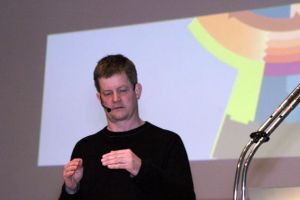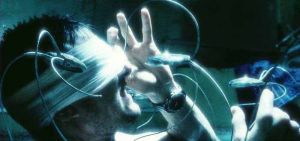 |
|
I Screen the Body Eclectic by Chris Bellamy
This column, which appears each issue, is meant to analyze a particular body of work within the sci-fi and fantasy genres - i.e. directors, writers, designers, etc.
|
March 2006
Darkness Falls
The behind-the-scenes artistic genius of Alex McDowell
When people talk about Oscar injustices, they point to the fact that the likes of
Hitchcock and Scorsese and Altman have never won, or that Philip Seymour
Hoffman and Paul Giamatti had never been nominated (i.e. appreciated) until this
year, or that sci-fi and fantasy - which makes up some of the most visionary work
of all - continue to get the proverbial shaft, slighted because of a genre bias.
But I like to speak up for the little guy as much as anyone, and in the public's eye
of the glitzy universe known as Hollywood, few people keep a lower profile than
the production designers. But that's okay - it's not like a film's sets, designs and
overall visual look actually matter or anything.
What is this all bringing me to? A little-publicized production designer named
Alex McDowell, who in a little more than a decade's time has put together one of
the most impressive resumes in the business. From one project to another,
McDowell continues to dazzle with some of the most dynamic and eclectic visual
work in Hollywood - and yet, in all this time, he hasn't been nominated for a
single Oscar. I mean, let me get this straight - Eminem has an Academy Award,
but this guy can't even pick up a nod from his so-called peers?
But I digress. That was getting a little sanctimonious, don't you think?
INTO THE DARK
Most people who work behind the scenes are
overlooked, simply because they are...well, behind the scenes. But McDowell's
case is peculiar considering his body of work. Maybe it was that whole genre bias
thing I was talking about. After all, he has worked with some of the darkest and
strangest filmmakers working today - Tim Burton, Terry Gilliam, David Fincher,
Alex Proyas. Even when he worked with Steven Spielberg, who isn't known as a
"dark" filmmaker - perhaps even the antithesis of such - McDowell oversaw the
design to the darkest and grittiest film of Spielberg's career, Minority Report. The
director himself even said he meant it to be the "ugliest, grittiest movie I'd ever
made."
But it's that darkness and grittiness that set McDowell's work apart from many of
his contemporaries. Quite interesting for a British lad who grew up going to
Quaker schools.
He once said in an interview that, before signing on for any film, the project has to
be "impossibly daunting." That philosophy, it seems, has taken him to the very
edge of the medium, working on films that have gone down as some of the most
visually unique of this generation - largely due to his artistic expertise. His
projects are almost never set in the real world; instead, the worlds he is
commissioned to create are typically expressionistic in one way another, with
countless possibilities in sets and costumes and photography.
 |
McDowell has the uncanny ability to match his
visual decisions perfectly with the themes and tone of each film he works on. Sure,
that seems like it's simply the basic job description of any production designer;
but we've all seen too many movies in which the visuals take a back seat to
everything else, and are never utilized to their fullest artistic capacities. Not so
with McDowell's work. Generally speaking, he doesn't do films that come off the
Hollywood assembly line. It's no coincidence that almost all of the films he has
worked on are defined largely by the way they look, by the visuals he helped
create.
Consider his second pairing with Spielberg, The Terminal. While that film is not
science fiction and thus won't be talked about in detail in this essay, it's worth
pointing out how much McDowell's work contributed to the overall effect of the
movie. Spielberg, McDowell and Co. didn't just rent out a section of a working
airport, but instead built and designed their own airport, to their exact
specifications. The effect was marvelous, and I would argue it was the best part of
an otherwise disappointing film. But, like I said, we'll leave The Terminal out of
this. And we'll just pretend The Cat in the Hat never happened. Everyone makes
mistakes. Even Alex.
MINORITY REPORT
McDowell has lent his talents to the form of a comic book movie, stop-motion
animation, sci-fi, you name it. Arguably his greatest accomplishment was the
aforementioned Minority Report, which simply couldn't have succeeded, or even
existed, without the production design that defines the film. As is the case with
most futuristic sci-fi, the visuals are crucial. Would Blade Runner have been
successful had Ridley Scott and his team not created such a perfectly realized
visual universe?
In order to create the futuristic, yet oddly
realistic, universe of fifty-years-in-the-future Washington, D.C. in Minority
Report, McDowell and his collaborators basically created an entire futuristic
world. They met with scientists, futurists and science-fiction writers to talk about
pending social and technological advances and came up with a universe that
blended those ideas with both modernism and old-fashioned aspects as well. The
result was one of the most phenomenal futuristic landscapes ever put on screen.
Consider the Pre-Crime building itself, which McDowell designed. All you see,
from top to bottom, is metal and glass, metal and glass. Because of those two types
of surfaces, the Pre-Crime offices are completely reflective, which plays into the
film's overall aesthetic. Throughout the film, everything is transparent, or
reflective, or both. There are no walls. There are no secrets, it seems. Spielberg
uses that transparency to great effect throughout the story; with the exception of
the opening scene in Georgetown and two scenes at the Andertons' cottage,
everyone seems to live in a glass house. Police officers used see-through,
miniature computer screens rather than paperwork; the pre-cogs' thoughts are
reflected on the ceiling of their chamber; computer discs are holographic; and, of
course, there are the brilliant sequences when John Anderton (Tom Cruise)
examines the "evidence" - the images coming from the pre-cogs' brains - once
again using an elaborate computerized system that is, once again, glassy and
transparent.
 |
As Spielberg mentions on the film's DVD,
scenes such as those represent one of Minority Report's most important themes:
seeing. In the world of this film, it seems, the entire world has gone transparent.
Government and law enforcement can peer into people's lives like it's nothing;
retinal scans are conducted at every block; and, most obvious of all, the pre-cogs
themselves "see" into the future. And who can forget the importance placed on
eyeballs during the surgery scene, and the subsequent brilliant "spyder" sequence,
in which Anderton's fellow officers search for him through a low-rent apartment
building using those mechanized spyders.
All of this relates quite significantly to Alex McDowell. From the design of the
spyders - which, while dormant, McDowell said he wanted to look like "a pager
designed by Porsche" - to the "womb-like" chamber in which the pre-cogs live, to
the brilliantly surreal "Hall of Containment," McDowell had a hand in it all - and
a big one. He was involved with the project almost from the beginning, studying
modern architecture, he says, and drawing concept art to create what would
become Washington D.C. circa 2054. The cold, bleak atmosphere - especially
contrasted with the utopia Anderton seems to be trying to create - is one of the
defining elements of Minority Report. The thought and inventiveness that went
into creating such a world is a stark contrast to so many recent sci-fi flicks such as
Aeon Flux, with their bright and colorful, cheaply synthetic production design.
THE REST OF THE OEUVRE
The year 2005 was a classic example of McDowell's ever-expanding portfolio.
Trying his hand in two completely different styles with cult favorite director Tim
Burton, McDowell designed both Charlie and the Chocolate Factory and Corpse
Bride. While I wasn't a fan of the former, what did stand out - not surprisingly, for
a Burton film - were the visuals. Sitting at the bottom of the hill - in the middle of
a beautifully realized England - the Bucket residence is a tragically dilapidated
and uneven little house, a major contrast to the kingdom-like factory that sits atop
the mountain, looking right down on poor old Charlie Bucket and his silly little
lopsided roof. And once we get to the factory itself, we're immersed in one of the
brightest and most colorful worlds I've ever seen.
McDowell and Burton use a similar kind of
contrast in Corpse Bride. In the real world, they give us drab colors, mostly
greyish, particularly in the somber opening sequences. The clothes are all grey, the
sky is grey, the inside of the large mansion is dark and depressing. But then, we
see the underworld, and finally we get color. Greens, blues, yellows, reds . . . the
world of the dead really is more appealing than the world of the living.
But perhaps the most important film of McDowell's career was the film that really
established him - Alex Proyas' 1994 comic book adaptation, The Crow. While
McDowell also worked on the sequel a few years later, it's the original film that
stands out the most, as his dark and menacing urban landscapes really paint the
picture for our revenge-driven hero. The noir-ish, metropolitan settings go a long
way to creating the moody atmosphere that the material requires.
Speaking of moody atmosphere, McDowell also
oversaw the production of Fight Club; once again, this proved to be a much
different task than anything he has done before or since, but once again, he found
a way to perfectly meld the material with the visuals. The dank basement at the
bottom of Lou's Tavern, with its one single light source hanging flimsily from the
ceiling, is the stage for many of the film's most powerful and/or violent moments,
but more importantly reinforces the anti-glamour, anti-commercialism, anti-image
attitude that the film has. Men like Brad Pitt may be rolling around without shirts
on, but it's certainly not the kind of "sexy" Hollywood is used to. Contrast is used
once again as we remember images of our narrator's "perfect" apartment lined
with furniture from the IKEA catalog. An even better example of the film's anti-IKEA Generation angle is the house on Paper Street; everything about it is
disgusting. It's grimy, the walls are tattered, the water is brown and almost all
scenes in the house are filmed with very little light, if any.
Dark lighting, dark thematic material, darkness. It defines Alex McDowell, a
former graphic designer who got into film after working on music videos in the
late `80s and early '90s. Now, more than a decade later, he can boast one of the
most considerable portfolios in Hollywood. As is true of so many great visual
artists, his work is never the same from project to project. In addition to the films
mentioned above, he also designed The Affair of the Necklace and Fear and
Loathing in Las Vegas, adding Gilliam to the growing list of notable directors he
has worked with.
With films covering subjects such as anarchy,
dystopia, moral retribution and more, McDowell seems to have a sense for the
fringes of Hollywood filmmaking. A few of his projects - namely Minority
Report, Fight Club and The Crow - are among the best, and certainly most
interesting, of their respective years and genres. But it might not be a stretch to say
that, without his contributions, that might not be the case.